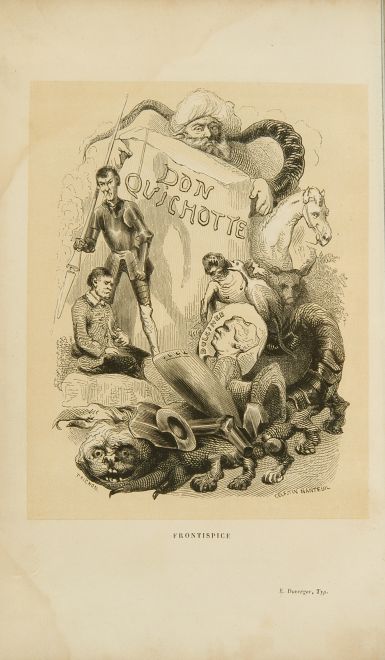Cide Hamete Berengeli holding Don Quixote; around it, don Quixote, Sancho, Dulcinea's portrait, Rocinante, the donkey, arms, the barber basin, the pack-saddle and monstrous beings.
Image in keeping with Romancticism frontispieces (Johannot, Gilbert...).
The quality of drawing and engraving is unequal; notice don Quixote and Sancho's figure, they are not too much good. |
Célestin François Nanteuil-Leboeuf (Rome, 1813 – Marlotte, 1873): Genre painter, designer engraver, acquafortist and lithographer. Nanteuil-Leboeuf was a youthful prodigy, developing a personal and recognizable style quite early on; when he was only 17 years old, he illustrated with lithographs Vogel’s L’Ange déchu, already showing his famous “tachiste” style. Originally a student of Ingres in the Ecole des Beaux-Arts and of Langlois, he was clearly a Romantic. His illustrations for Renduel’s edition of Victor Hugo’s Notre Dame de Paris (1836) are very remarkable; Nanteuil was a close friend of this writer. His style was very appropriate for illustrating the imaginative creations of Romantic poets and writers. In 1867, he became Director of the Academy of Fine Arts and, in 1869, he was awarded with the Légion d’honneur. He, perhaps, is best known today for his numerous and very effective lithographs (Benezit VII, 650-651).
Auguste or François Auguste Trichon (Paris, 1814 - ?): Wood engraver. Trichon, K. Brown’s disciple, exhibited at the Salon in 1848 by the first time. He was one of the most popular wood engravers. He worked for Les Etrangers á Paris, Musée des Familles, L’Illustration, Le Journal pour tous, Le Magasin des Enfants, L’Universe Illustré, etc. (Benezit X, 272). |
